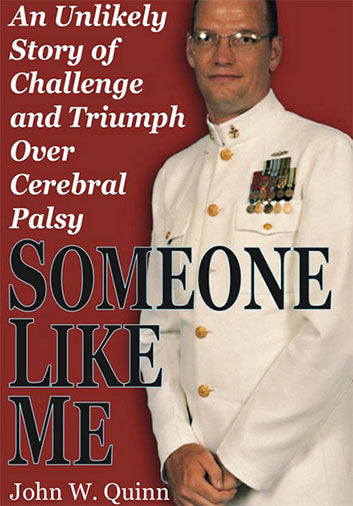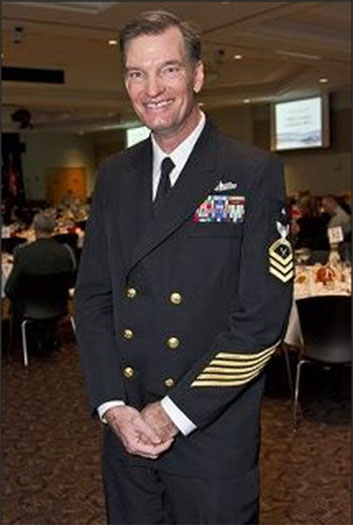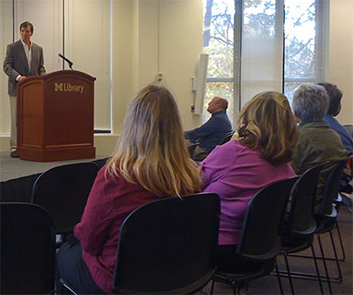Internal mini form
Contact Us Today
Sailor’s Cerebral Palsy did not stop him from serving

Normally, John Quinn wouldn’t tell a person to purposively overlook disclosing a condition like Cerebral Palsy, but in his case, doing just that was necessary to get where he wanted to go.
John, now 50 and retired after a 20-year career in the US Navy, is an example of a person who persevered to achieve his goals despite having interference from a mild to moderate case of Cerebral Palsy.
What sets his story apart is that he chose one of the most physically demanding careers – that of a sailor. What’s more surprising is that no one in the US Navy knew he had Cerebral Palsy.
“I didn’t tell anyone about it because I knew that it meant I would never be able to serve,” said John, who lives in Tucson, Az. “They wouldn’t have given me the opportunity to try. That’s as true today as it was when I first enlisted.”
Being a sailor means maintaining a high-level of physical fitness which John achieved as he grew older – and stronger. The military sets high standards of fitness, and for John, getting to the point where he could pass a Navy physical was no easy task.
“It was very hard,” he remembers. “But it wasn’t impossible.”
The growing up part
John grew up as one of seven children to Edgar and Shirley, the former of which was a Detroit Police Officer. He grew up in the blue collar enclave of Garden City, Mich., which is about 17 miles outside Detroit.
Diagnosed with Cerebral Palsy as an infant, John was unable to walk until he was 4 years old. Mastering this skill was the first achievement in what would become a series of milestones conquered.
John described his childhood as normal, although he was often the target of taunts from his peers because of Cerebral Palsy.
“I was physically weak, and I was different,” he said. “There were times I was definitely bullied by other kids, but I tried not to let that get me down. I also had four brothers that could intervene on my behalf.”
Growing up, John said his siblings didn’t treat him different.
“That’s one of the reasons I was able to join the military,” he said. “My parents were never too quick to pick me up if I fell – they let me know that I would have to do that for myself. My parents let me try anything I wanted to try.”

After graduating from Garden City High School, John enrolled in Schoolcraft College, a small community college that was near his home. He did so with the intention of studying computer programming – a growing field at the time.
“I knew that computers were going to be used by people and that there would be work there,” he said. “I thought it would be a good field to get into.”
But a funny thing happened on the road to a degree: Computers, and college at large, didn’t capture John’s imagination, his propensity towards service, or his desire for adventure.
“I remember that I put all of my books into the fireplace,” he said. “I already knew I wanted to serve [in the military]. I use to see one of my brothers come home in his military uniform. It left an impression on me.
“My father gave me two weeks to figure something out. So, I walked across the street to the military recruiter’s office.”
The process by which John joined the Navy began with one failed attempt. He had passed the battery of tests. He had met all the military’s requirements. But, he failed his final exercise. His efforts were disappointingly derailed – temporarily.
“We were asked to perform this exercise called a duck walk, where you squatted and walked at the same time,” he said. “I tried to do it, and fell over.”
Now, John certainly wasn’t the only potential recruit to fall over while attempting the awkward movement. Instead of setting aside his dreams, he left the recruiter’s office with more resolve than ever before.
“I didn’t tell anyone about it because I knew that it meant I would never be able to serve. They wouldn’t have given me the opportunity to try. That’s as true today as it was when I first enlisted.”
– John Quinn
“We were asked to perform this exercise called a duck walk, where you squatted and walked at the same time. I tried to do it, and fell over…I went to my basement in Garden City and practiced that duck walk,” John said. Several months later, he made his second attempt to join the Navy. “That time, I was the best duck walker in the room.”
– John Quinn
When he went home and told his parents what happened, Dad asked: “What are you going to do about it?
It didn’t take John long to devise a plan. “I went to my basement in Garden City and practiced that duck walk,” he said. Several months later, he made his second attempt to join the Navy.
“That time, I was the best duck walker in the room,” he said.
The second time was the charm. John successfully enlisted in 1982, and his career as a sailor began.
The service component
During his career, John was named the Administrative Leading Chief of the USS John C. Stennis, the Awards Branch Head at the Commander Naval Surface Force US Pacific Fleet, and the Assistant Ship Secretary of the USS Dwight D. Eisenhower. The Navy would take John around the globe, including an assignment in the Middle East during the first Gulf War in the 1990s, before his retirement.

There would be times when his condition was a challenge.
“It was hard to stand watch for eight to twelve hours or more,” he said. “But that would be difficult for anyone to be on their feet for that long.”
John retired in 2002, as a Senior Chief Petty Officer, the second highest rank available for enlisted sailors.
The difference
John says there were several aspects that lined up perfectly in terms of his successful military career.
The first is that his family instilled in him how important it was to focus on his abilities, not his disabilities. The second is that they saw the value in service.
“I enjoyed my military career and I enjoyed having the responsibility of a sailor,” he said. “My family supported that.”
Today John is a successful public speaker. He talks about his experiences with Cerebral Palsy and military life to varied audiences.
He said that when he looks back on his experiences, he knows that although some positive changes have taken place for people with disabilities, there are other things that are exactly the same as they were when he walked into the military recruitment office in the early 1980s.

“We’re still trying to open doors; were still trying to be included,” he said. “And there are still doors that are closed.”
John has some advice for young people with disabilities.
“You should never let the fact that you have a disability stop you from pursuing your dreams,” he said. “It may take some work, and you may have to try more than once. But, don’t give up.”
John has put his story to pen and paper. His book, “Someone Like Me: An Unlikely Story of Challenge and Triumph Over Cerebral Palsy,” (Chronology Books) was published in 2010. In the book, John details how his career progressed and the challenges and successes he met along the way.
Currently, John is considering adapting his book into a screenplay. He has some nibbles from Hollywood, the first step in taking his story to the big screen. He’s also considering writing a series of children’s books about disability.
Others sometimes look at John’s career with a sense of amazement; John tends to see it as the result of a lot of hard work.
“You have to be able to work for what you want,” he said.
For more information on John:

Athletes with Cerebral Palsy
Athletes are mythic figures that have used their bodies to achieve an enviable level of fitness. Although most people don’t associate individuals with Cerebral Palsy with sports and other acts of endurance, these athletes use their bodies to achieve feats of physicality that are only surpassed by personal satisfaction and confidence.
- Sam Broughton – Martial Arts
- Drew Dees – Shot Put
- James “Rooster” Gallion – Parkour
- Dick and Rick Hoyt – Triathletes
- Benjamin Jackson – High School Sports
- Cody and Cayden Long – Triathletes
- Linda Mastandrea – Paralympian
- Ryan McGraw – Yoga
- Kyle and Brent Pease – Triathletes
- John Quinn – Navy
- Jack Runser – Wrestler and Bodybuilder
- Jerry Traylor – Mountain Climber
- Marty Turcios – Golfer
- Ahkeel Whitehead – Paralympic Hopeful
- Duncan Wyeth – Paralympian








